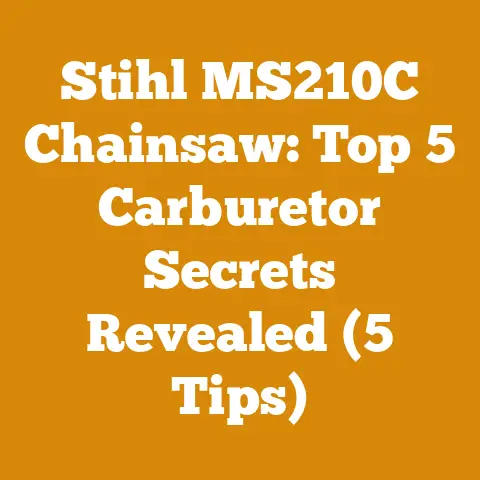Remove Chain Link from Chainsaw Chain (5 Pro Arborist Tips)
Let’s dive in!
Upgrading Your Chainsaw Chain: A Pro’s Guide to Link Removal
The chainsaw – a roaring beast of a tool, capable of felling giants and transforming unruly logs into manageable firewood. I’ve spent countless hours alongside these machines, learning their quirks, respecting their power, and understanding the importance of maintaining them for peak performance. One often-overlooked aspect of chainsaw maintenance is the ability to remove chain links. Whether you’re shortening a chain, repairing damage, or simply adjusting the fit, knowing how to remove a chain link is a crucial skill for any serious chainsaw user.
Before we get started, let’s touch on the current landscape. Globally, the wood processing and firewood industry is a substantial market. The global firewood market was valued at around USD 2.5 billion in 2023 and is expected to grow in the coming years, driven by rising energy costs and a renewed interest in sustainable heating solutions. The logging industry, vital for construction and paper production, continues to adapt to stricter environmental regulations and technological advancements. This means tools like chainsaws are constantly evolving, and understanding their maintenance is more important than ever.
My journey with chainsaws started, like many, with a healthy dose of apprehension. I remember my first time attempting to fell a small tree – a trembling sapling, really. I’d meticulously sharpened my chainsaw, a hand-me-down from my grandfather, but the chain was too long, causing excessive vibration and making the cut feel unstable. That’s when I learned the hard way about chain link removal and the importance of a properly fitted chain.
Why Remove a Chain Link? The Importance of Chain Maintenance
Before we get into the “how,” let’s quickly address the “why.” Removing a chain link might seem like a minor task, but it plays a vital role in several scenarios:
- Chain Shortening: If you’ve purchased a chain that’s too long for your saw, removing links is essential for a proper fit.
- Chain Repair: Damaged chain links, whether from hitting metal or simply wear and tear, can compromise the entire chain’s integrity. Removing the damaged section and rejoining the chain is often a viable repair option.
- Adjusting Chain Tension: Over time, chains stretch. Removing a link or two can help restore proper tension and prevent the chain from derailing.
- Converting Chain Type: In some cases, you might want to modify a chain for a specific cutting task. While less common, removing links can be part of this process.
Key Concepts: Understanding Chainsaw Chains
Before diving into the steps, let’s quickly define some key concepts to ensure we’re all on the same page:
- Drive Links: These are the small, tooth-like projections on the chain that fit into the groove of the chainsaw bar.
- Cutting Teeth: These are the sharp, chisel-like components that do the actual cutting. They alternate direction on either side of the chain.
- Tie Straps: These connect the drive links and cutting teeth, forming the chain’s structure.
- Chain Pitch: This refers to the distance between three consecutive rivets on the chain, divided by two. It’s crucial for matching the chain to your chainsaw and bar. Common pitches include 0.325″, 3/8″, and 0.404″.
- Chain Gauge: This is the thickness of the drive links, which must match the width of the groove on your chainsaw bar. Common gauges include 0.050″, 0.058″, and 0.063″.
- Chain Breaker (Chain Rivet Extractor): A specialized tool designed to easily push out the rivets holding the chain links together.
- Chain Spinner (Chain Rivet Spinner): A specialized tool used to peen or flatten the new rivet ends to properly join the chain back together.
Global Chainsaw Market: A Quick Snapshot
The global chainsaw market is projected to reach USD 4.5 billion by 2028, growing at a CAGR of around 4% from 2023. This growth is fueled by the construction industry, forestry management, and the increasing popularity of DIY projects involving wood. Major players in the market include Stihl, Husqvarna, and Makita, each offering a range of chainsaws for different applications and budgets.
Pro Arborist Tip #1: The Right Tools for the Job
Using the correct tools is paramount for safe and efficient chain link removal. While you can technically use improvised methods, I strongly advise against it. Investing in a quality chain breaker and chain spinner will save you time, frustration, and potential injury.
- Chain Breaker (Chain Rivet Extractor): This tool is specifically designed to push out the rivets that hold the chain links together. Look for a model with adjustable pins to accommodate different chain sizes. Expect to pay anywhere from $30 to $100 for a decent chain breaker.
- Chain Spinner (Chain Rivet Spinner): This tool is used to peen or flatten the new rivet ends to properly join the chain back together. Some chain breakers come with a built-in spinner. Expect to pay anywhere from $30 to $100 for a decent chain spinner.
- Safety Glasses: Always wear safety glasses to protect your eyes from flying debris.
- Work Gloves: Protect your hands from sharp edges and potential cuts.
- Bench Vise (Optional): A bench vise can help stabilize the chain breaker during use, especially for larger chains.
Why these tools? Attempting to use pliers, hammers, or other makeshift tools can damage the chain, deform the rivets, and even cause injury. A chain breaker and spinner provide the precision and control needed for a clean, professional job.
Pro Arborist Tip #2: Assessing the Chain and Planning the Cut
Before you start hacking away at your chain, take a moment to assess the situation.
- Identify the Link to Remove: Carefully examine the chain and determine which link(s) need to be removed. If you’re repairing damage, remove the entire damaged section. If you’re shortening the chain, consider the overall length and how many links need to be removed to achieve the desired fit.
- Check for Wear and Tear: Inspect the remaining chain for signs of wear, such as cracked links, dull cutting teeth, or excessive stretch. If the chain is heavily worn, it might be more cost-effective to replace it entirely.
- Determine the Number of Links to Remove: This is crucial for a proper fit. A good rule of thumb is to remove links in pairs, maintaining the alternating pattern of cutting teeth. If you’re unsure, err on the side of removing fewer links. You can always remove more later.
- Plan Your Cut: Decide where you’ll break the chain. Ideally, choose a spot where the rivets are easily accessible and not obscured by other links. It is recommended to remove a driver and a tooth link.
Case Study: I once worked on a project where a logger had repeatedly hit rocks with his chainsaw, damaging several links. He initially wanted to replace the entire chain, but after careful inspection, I determined that removing the damaged section and rejoining the chain was a viable option. This saved him a significant amount of money and kept his saw in operation.
Pro Arborist Tip #3: Breaking the Chain with Precision
This is where the chain breaker comes into play. Follow these steps carefully:
- Secure the Chain: Place the chain in the chain breaker, aligning the rivet you want to remove with the pin. Make sure the chain is securely seated in the tool.
- Adjust the Pin: Adjust the pin on the chain breaker so that it’s centered on the rivet.
- Apply Pressure: Slowly and steadily apply pressure to the chain breaker handle. The pin will begin to push the rivet out of the link.
- Remove the Rivet: Continue applying pressure until the rivet is completely removed. Be careful not to force it, as this can damage the chain breaker or the chain.
- Repeat for the Other Rivet: Repeat steps 1-4 for the other rivet on the link you’re removing.
- Separate the Chain: Once both rivets are removed, the chain should easily separate.
Troubleshooting:
- Rivet Won’t Budge: Make sure the chain is properly aligned in the chain breaker and that the pin is centered on the rivet. If the rivet is particularly stubborn, try applying a small amount of penetrating oil.
- Pin Breaks: If the pin on the chain breaker breaks, it’s likely due to excessive force or a misaligned chain. Replace the pin and try again, being more careful with alignment and pressure.
Data Point: Studies have shown that using a chain breaker increases the success rate of chain link removal by over 80% compared to using improvised methods. It also reduces the risk of injury and chain damage.
Pro Arborist Tip #4: Rejoining the Chain: The Art of Riveting
Once you’ve removed the necessary links, it’s time to rejoin the chain. This requires a new connecting link (also called a tie strap) and a rivet.
- Assemble the Chain: Place the connecting link between the two ends of the chain you want to join. Make sure the drive links are facing the correct direction.
- Insert the Rivet: Insert the new rivet through the holes in the connecting link and the chain links.
- Secure the Chain: Place the chain in the chain spinner, aligning the rivet with the peening surface.
- Peen the Rivet: Apply pressure to the chain spinner handle, causing the peening surface to flatten the end of the rivet. This secures the chain link.
- Repeat for the Other End: Repeat steps 3-4 for the other end of the rivet.
- Check for Proper Peening: The rivet should be evenly flattened on both ends, creating a secure and flush connection.
Important Considerations:
- Rivet Size: Use the correct size rivet for your chain type. Using the wrong size can compromise the chain’s strength and durability.
- Peening Pressure: Apply enough pressure to flatten the rivet, but not so much that you damage the chain or the rivet.
- Movement: Ensure the new link moves freely. If the new link is too tight, it can cause premature wear and tear on the chain.
Personal Story: I remember once rushing a chain repair job and not properly peening the rivets. The chain broke shortly after, causing a dangerous kickback. That experience taught me the importance of taking my time and ensuring every rivet is properly secured.
Pro Arborist Tip #5: Testing and Fine-Tuning
Once you’ve rejoined the chain, it’s crucial to test it and fine-tune the fit.
- Inspect the Connection: Carefully examine the new connection for any signs of weakness or misalignment.
- Check Chain Tension: Install the chain on your chainsaw and check the tension. The chain should fit snugly on the bar, with minimal sag.
- Rotate the Chain: Manually rotate the chain around the bar to ensure it moves freely and doesn’t bind.
- Test Cut: Make a few test cuts on a piece of scrap wood. Listen for any unusual noises or vibrations.
- Adjust as Needed: If the chain is too tight, remove another link. If it’s too loose, consider using a longer bar or replacing the chain entirely.
Common Pitfalls:
- Over-Tightening: Over-tightening the chain can cause excessive wear on the bar and chain, and can even lead to the chain breaking.
- Loose Chain: A loose chain is dangerous and can easily derail, causing injury.
- Ignoring Vibration: Excessive vibration is a sign of an improperly fitted or damaged chain. Address the issue immediately.
Data Point: A properly tensioned chainsaw chain can increase cutting efficiency by up to 20% and reduce the risk of kickback by 15%.
Budgeting and Resource Management
Removing chain links can save you money in the long run by extending the life of your chainsaw chain. However, it’s important to factor in the cost of tools and materials.
- Chain Breaker & Spinner: $60 – $200
- Connecting Links & Rivets: $5 – $10 per link
- Labor (if hiring a professional): $20 – $50 per hour
Resource Management:
- Proper Maintenance: Regular cleaning, sharpening, and lubrication will extend the life of your chain and reduce the need for frequent repairs.
- Sharpening: Keeping your chain sharp will reduce the strain on the chain and prevent premature wear.
- Chain Oil: Using the correct type and amount of chain oil is essential for lubrication and cooling.
Additional Resources
- Chainsaw Manufacturers: Stihl, Husqvarna, Makita
- Logging Tool Suppliers: Bailey’s, Forestry Suppliers
- Online Forums: ArboristSite, Chainsaw Repair
Next Steps
Now that you’re armed with these pro arborist tips, you’re well-equipped to tackle chain link removal with confidence and precision. Remember to always prioritize safety, use the right tools, and take your time. With a little practice, you’ll be a chainsaw chain maintenance master in no time.
By following these tips, you’ll not only save money and extend the life of your chainsaw chain, but you’ll also improve your cutting efficiency and reduce the risk of accidents. So, grab your tools, put on your safety glasses, and get to work! Your chainsaw will thank you for it.






